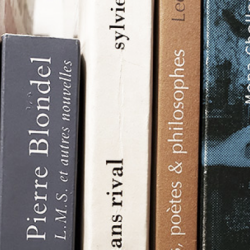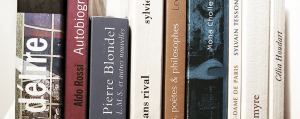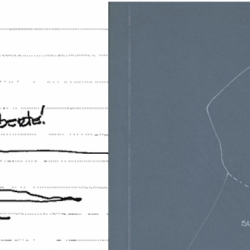

Why write fiction when you are an architect? If the role of professionals in architecture is not, a priori, to write stories, some of them have a privileged relationship with literature. This is the case of Sergio Morales, a Quebec architect (co-founder of Chevalier Morales Architectes, a studio based in Montreal) and Pierre Blondel, a Belgian architect (founder of Pierre Blondel Architectes, a studio based in Ixelles). We went to meet them in order to better understand the place that writing occupies in their practice as designers (1).
Practitioners and teachers, they have in common that they take the pen to expand the limits of representation in architecture. Both of them bring fictional characters to life in their projects, particularly in competition situations. When Sergio Morales summoned Nadia Comaneci and revived Jean Drapeau and Youri Gagarin in the competition for the Montreal Planetarium in 2008, Pierre Blondel invented a story between three characters – Lucie, Marc and Simon – who frequent three buildings he designed. This story is set in the difficult commission of a prostitution center and two social housing buildings in Belgium. It also gave its title to the book L.M.S. et autres nouvelles, published in 2011 by Éditions Fourre-Tout of Liège, followed by Professeur Toumani Inc, published in 2019 by Éditions Ercée of Brussels. In addition, each of our architects is the main writer of the project texts of his studio. For Sergio Morales, there are “many voices in one that passes through a pen”. For Pierre Blondel, this work “in the background” is necessary for the good balance of the architect. Both have also won competitions on both sides of the ocean for a literary institution – a “house” of literature in Quebec or a “museum” of literature in Belgium.
The Maison de la Littérature de l’Institut canadien de Québec “particularly touches” Sergio Morales, insofar as it brought “a program that was new”. For the architect, it was a testament to the many forms that literature could take at the time of the competition, in 2011: “We wanted to interest young people with everything that is done in the more current world of literature, whether it is poems on Twitter (…). There is writing everywhere, not only in great works of the 19th century or the beginning of the 20th century here”. Pierre Blondel also testifies to his enthusiasm for the Archives et Musée de la Littérature program, which he began in 2006, “a special thing,” which marked the beginning of the fictions around his projects: “This is my entry, if I may say so, into writing. I like reading a lot, but I had never written before. Blondel thus associated each piece of the planned building with a short story and read all the texts during the competition oral: “There was even an epilogue to the competition that described the building twenty or thirty years later, once it was built. Finally, the literature no longer existed or was no longer of interest, so it was decided to transform the entrance into a reception area for a large mall that was to be built later.
What then are the reasons that led our two architects to pursue this fictional writing, taking as a setting their future buildings? Pierre Blondel explains them in the introduction to L.M.S. et autres nouvelles. Words allow him to represent and describe space in a form that favors use, authorizes the introduction of sounds and smells, and breathes lightness into a profession marked by administrative red tape and the weight of responsibilities, but also to defy time, by bringing the project to life even though the construction site has not yet begun. He adds that there is “an almost ‘psychoanalytical’ virtue: I write about things when they are really beyond me. When I started working on religion and boxing, it was completely beyond me. And then literature comes in – and literature is an escape. However, the Belgian architect insists that the fictional text, which he usually starts writing at the beginning of the design process, is not directly related to the configuration of the project: “Architecture is always a kind of mystery: you ask yourself why you do architecture and how you manage to do it. (…) Many people have said to me: “Oh yes, that’s great, for you, literature is a tool for architectural design”. No! Unfortunately, no. The design of the project often goes faster than the story itself, and it is only a few “small links”, a few “small connections” that take place from the text to the project. The only case where writing can have this operative value is, for Pierre Blondel, the situation of pedagogical blockage. Asking a student in a deadlock to “tell a story” can help him or her move forward in the project process.
The writing occupies a very different place in the projection for Sergio Morales. On the contrary, it is a “design tool” in its own right, “a real driving force in the project”. The writing activity is concomitant, even intrinsic to the design: “The discourse of the project – and this is something that has become obvious to me – is written at the same time as the project”. He insists: “There is not the discourse before, then the project after”. Moreover, this writing that transforms the project is a narrative that is always in motion: “Sometimes it can be written afterwards, in retrospection – we rewrite the discourse. The architect “images” the project as much as he writes it. The text constitutes in fact “a way of approaching the context which is more creative and imaginative, which is that of going to understand, the history the events, the accidents of emotional nature which tint the places”. The words sculpt, the pen already configures the building in the making: “Writing is like a can opener, it serves to open the project to an original reading. A design tool as powerful as the sketch, the three-dimensional image or the model, writing in a competition situation retains a certain specificity, according to Sergio Morales: “For this exercise, we have to sit down, think, organize our ideas, make sure we are clear. It’s not really creative writing, but there is something that appears in the text that feeds us. The characters introduced in the stories of the architect are so many “voices to be heard”, which constitute the primary function of writing according to Sergio Morales, “that of a channel of transmission to the object, that is to say that what is written in the end, it would be nice to be able to read it in the building”.
As to whether architectural writing is self-conscious, that is to say, whether there is writing tinged with disciplinary specificity in architecture, our two architects remain cautious. Pierre Blondel considers that fictional writing is singular in that it relieves the architect of financial and legal responsibilities: “Writing is a light thing. It takes as much time as architecture – you have to reread a hundred times – but it’s different. Yet he notes that his writing does have something “architectural” about it, its structure sometimes akin to pictorial composition or mirror construction: “What I’ve noticed – and what several people have pointed out to me – is that a lot of the short stories and stories are very strongly ‘constructed. For example, Berger, is a story composed with several characters that must lead to a final tableau. It is a choral writing where each one has his part in the edifice and must, at some point, participate in what will be this final”. Sergio Morales considers that he writes texts in architecture as he would write texts called “literary”: “I would say that it is not an architectural writing as such, it is just a fiction that is built and is fed by a project in the making.
In answer to our initial question – why write fiction when you are an architect? – we could say that if architects write fictions around the architectural project, it is because this one is already, by essence, fictional (2). Our comparison highlights two ways of approaching writing in architecture. On the side of Sergio Morales, we can speak of a productive writing that is intrinsic to the exercise of architecture. This textuality is addressed to certain people who need to be convinced, and not only for the pleasure of writing. A real design tool, it is operative and performative. The text reconfigures the building in the process of being made. We can therefore speak of a writing of the project. For Pierre Blondel, the writing is more independent, accompanying, even parallel to the exercise of the project. More like writing “for oneself”, it participates in the architect’s equilibrium and does not follow the same temporality as the project in the process of being woven. It constitutes an escape, a step back. Its prescription makes it possible to solve a blockage in a student. It also gained its autonomy compared to the buildings in the making, since it exists in the form of published works – two “literary buildings”. We will then speak of writing as a project. The status of writing in a competition situation remains to be determined. Is it a function of the designer, or is it a side activity? Are there juxtapositions or collisions between architecture and literature? To use Roland Barthes’ expression (3), is the architect with a pen an “écrivant” or an “écrivain” (4)?
- The fragments of quotations in quotation marks in this post are transcripts of interviews conducted respectively with Sergio Morales and Pierre Blondel by Zoom in the spring of 2021.
- According to Jean-Pierre Boutinet, the paradigm of any project is that of an object that is both real and mental: “Every building constructed expresses in a certain way the realization of a project or at least of an intention that it has endeavored at a certain time to concretize. The project is thus the obligatory passage towards the realization of the architectural work. This last, once completed is on its side the translation more or less faithful of an old project which anticipated it but does not exist any more “, in Anthropologie du projet, Presses Universitaires de France, Paris, 2012 (first edition 1990), p.189
- Roland Barthes, “Écrivains et écrivants”, in Essais critiques, Seuil, 1964
- See the beautiful reflection proposed by Jean-Louis Cohen on the occasion of a study day at the Collège de France. Architecture and literature: fiction, rhetoric and poetics, May 2021 (replay online).

